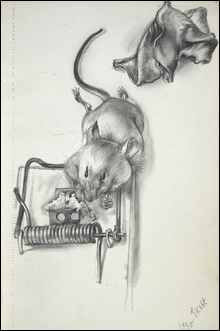Artists’ notebooks at the Fogg, issues of extinction at the Gardner, and ‘Photographing Great Horses’ at the Fitchburg
By RANDI HOPKINS | July 19, 2006

George Grosz, Dead Mouse in a Trap |
Art — like music, physics, literature, dance, and other creative pursuits — rarely springs forth from the imagination in its final form. Ideas pop up, thoughts come to mind, and the artist reaches for pencil and notebook to set something down in its rawest form, to remember it, to start playing around with it. Bruce Chatwin was famously attached to his moleskin-covered notebooks and Mont Blanc fountain pens, the young Keith Haring filled sketchbooks with logos of bands including the Grateful Dead and Led Zeppelin, and Woody Guthrie committed not only lyrics but also cartoons, watercolors, and pen-and-ink drawings to his journals. Harvard’s Fogg Art Museum has nearly 150 artists’ sketchbooks in its collection ranging from the 18th century to the 1990s, but these fragile volumes — curved from transport in artists’ back pockets, weak where pages have been torn out — are rarely put on view, so with more than 70 sketchbooks and 45 drawings, “Under Cover: Artists’ Sketchbooks,” which opens at the Fogg on August 1, provides an uncommon chance to peek at preliminary drawings and notes by the likes of Jean-Honoré Fragonard, John Singer Sargent, George Grosz, and Henry Moore. Intact sketchbooks will be shown open to a particular page, alongside drawings that the Fogg acquired after they had been removed from their original books. Intrigued by the Isabella Stewart Gardner Museum’s “Henrik Håkansson: Cyanopsitta spixii Case Study #001,” which is up through September 17? Haven’t seen it yet? On July 26, Scott Edwards, professor of organismic and evolutionary biology and curator of ornithology at Harvard’s Museum of Comparative Zoology, gives a noontime talk in the Gardner’s special exhibition gallery about the Spix’s macaw, a species on the brink of extinction. A rare 19th-century specimen of this bird, on loan from Harvard, is at the heart of Håkansson’s compelling exhibition.

Over the past decade, Robert Sargent Fay has often photographed people and places associated with the arts, such as the Apple Hill Center for Chamber Music in Nelson, New Hampshire, and Ken Burns and his Florentine Films in Walpole, New Hampshire. His work also reflects his interest in history, the American West, and the extraordinary beauty he finds in horses. “Kindred Spirits: The Intimate Photographs of Robert Sargent Fay,” at the Fitchburg Art Museum through September 10, features some 40 works, and on August 3, Fay presents the workshop “Adventures in Photographing Great Horses,” in which he’ll talk about horses who left a lasting impression on him and offer tips on photographing equines and other animals. Bring your own brown-bag lunch and think good thoughts about Barbaro.
“Under Cover: Artists’ Sketchbooks” at Fogg Art Museum, 32 Quincy St, Cambridge | August 1–October 22 | 617.495.9400 or www.artmuseums.harvard.edu | “Noontime Talk: Scott Edwards” at Isabella Stewart Gardner Museum, 280 the Fenway, Boston | July 26 at noon | 617.566.1401 or www.isgm.org | “Kindred Spirits: The Intimate Photographs of Robert Sargent Fay” at Fitchburg Art Museum, Merriam Parkway, Fitchburg | through September 10 | “Adventures in Photographing Great Horses” August 3: 12:15-1:15 pm | 978.345.4207 or www.fitchburgartmuseum.org
 Related
Related:
Bookworms, To the lighthouse, Don’t leave me this way, More 
- Bookworms
“Under Cover” is one of those lucid, edifying shows the Harvard museums excel at.
- To the lighthouse
Word has it that famed, Boston-born artist Winslow Homer learned to paint from his mother, a skilled amateur watercolorist of flowers who recognized her son’s talent for drawing from the time he could hold a pencil.
- Don’t leave me this way
Leaves lead a wild life, and each leaf’s physical structure reflects both its individual biography — revealing the pathways, for example, of insects that have eaten their way across a leaf’s surface.
- The case of the zombie Pollocks
On Monday, Harvard researchers kicked a hornets’ nest that has been buzzing in the art world since the discovery of 32 drippy abstract paintings claimed to be previously unknown works by Jackson Pollock.
- Back in the USSR
Gulag is the Russian acronym for the government agency that administered the famously harsh system of forced labor camps in the former Soviet Union, but it has come to refer more generally to that system of prisons and detention facilities.
- Very funney
Early William Wegman videos on YouTube are grainy black-and-white mini-musings on watching and being watched.
- My Baby Shot Me Down
“Abstract painting” is a broad historical category that takes in everything from the utopian spiritual and formal purity of the early decades of the 20th century to the macho of the purely visual as championed by Clement Greenberg later in that century.
- Fight the power
Art mixes it up with history and politics, peers closely at electronic surveillance, worries about its own usefulness, traipses down the fashion runway, and brings cool stuff back from China and Puerto Rico in exhibitions opening this fall.
- Must warn others
It’s a cliché of bad novels and late-night movies that scientists and artists represent two extreme — and mutually exclusive — poles of objectivity and subjectivity.
- Turn on the bright lights
Art this fall grapples with issues like gender and journalism, personal space and human survival, and what to have for lunch.
- Less

 Topics
Topics:
Museum And Gallery
, Science and Technology, Harvard University, The Grateful Dead, More  , Science and Technology, Harvard University, The Grateful Dead, Led Zeppelin, Biology, Life Sciences, Sciences, Physics, Visual Arts, Cultural Institutions and Parks, Less
, Science and Technology, Harvard University, The Grateful Dead, Led Zeppelin, Biology, Life Sciences, Sciences, Physics, Visual Arts, Cultural Institutions and Parks, Less 